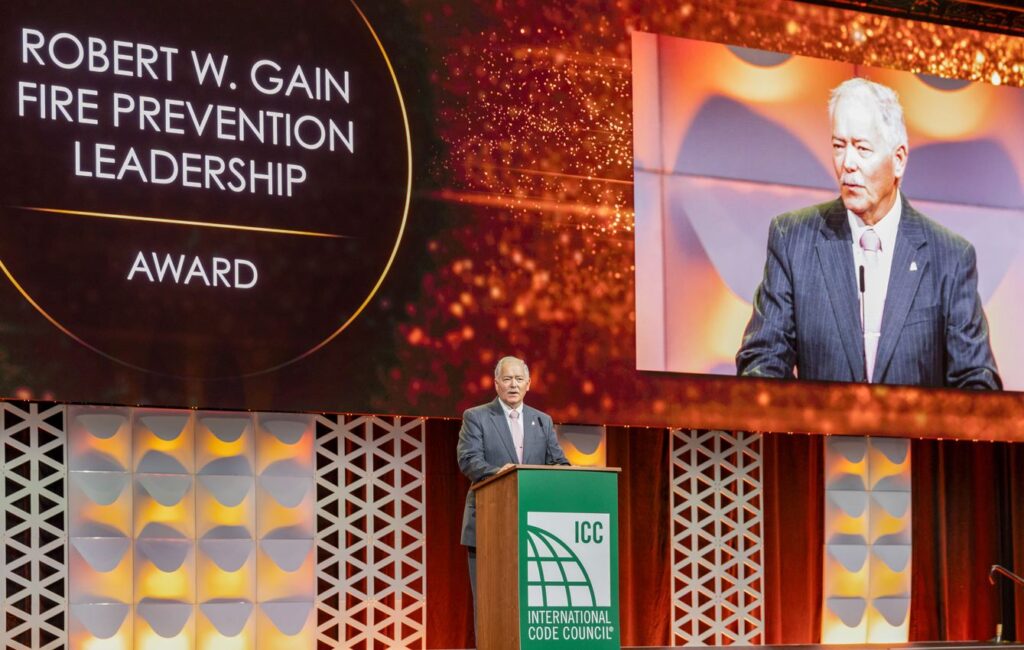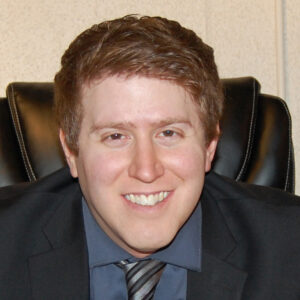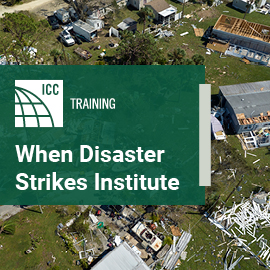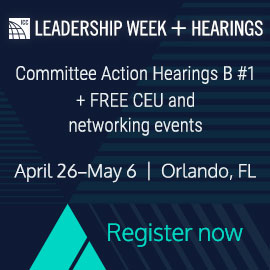
Former Utah State Fire Marshal Coy Porter Receives 2024 Robert W. Gain Fire Prevention Leadership Award
The Code Council is proud to honor Coy Porter, former Utah State Fire Marshal and current Utah State Fire Prevention Board Chair, with the 2024 Robert W. Gain Fire Prevention Leadership Award.
When colleagues talk about Coy Porter, retired Utah State Fire Marshal and recipient of the International Code Council’s 2024 Robert W. Gain Fire Prevention Leadership Award, they don’t solely talk about his commitment to fire safety. The thing that stands out most is Porter’s ability to bring people together. In doing so, he has improved the awareness and acceptance of fire codes and fire safety and has helped establish a safer environment for all.
“Coy has been an icon in our community both in Utah as well as the Code Council,” said Thomas Peterson, CBO, who serves as the Building Official for the Division of Facilities Construction and Management within the Taylorsville State Office Building in Utah. “He’s brought groups of people together that oftentimes struggle to see eye-to-eye.”
The Robert W. Gain Fire Prevention Leadership Award is presented annually to individuals who demonstrate exceptional leadership and longstanding dedication in support of fire codes and fire prevention. Porter’s award comes after a career spanning more than 44 years – and even now in retirement, his service is not yet complete. In 2022 Porter was appointed to the Utah State Fire Prevention Board as a Member-at-Large and is the current Chairperson.
“The award was named after Chief Gain because of all the work he did in California,” said Porter. “He’s known as the father of modern fire codes, so it’s quite an honor to be recognized. It was very unexpected. I am very appreciative of that.”

Bridging the Gap Between Interests
Porter, who has lived in Provo, Utah his whole life, started his career with the Provo Fire Department in 1977. His 30-year tenure culminated during the last five years when he served as the department chief. He then joined the Utah Fire and Rescue Academy at Utah Valley University, serving as an Assistant Director of Training. He also served as Incident Commander (IC) for the annual Winter Fire School, an intense training event that attracts hundreds of Utah firefighters.
“While I was working there, we got a new State Fire Marshal, someone I’d known for 25-30 years, and he asked me to come be his Chief Deputy,” Porter recalled. “Eighteen months later he retired, and I became the State Fire Marshal for the next nine years. In a roundabout way, I went from fighting fires to trying to prevent them.”
In 2001 Porter received the Community Emergency Response Award from the Utah Department of Health: Bureau of EMS. He was elected as the second Vice President of the Utah State Fire Chiefs Association in 2003 and elected as President in 2005. In 2004 he was elected as President of the Greater Salt Lake Valley Fire Chiefs Association. He also served as a member of the Code Council’s 22-member ad hoc committee for Building Safety and Security.
Porter was instrumental in promoting and explaining the value of the International Fire Code® (IFC) to the Utah State Legislature, which adopted the 2012 IFC, followed by the 2015 IFC and 2018 IFC. He has served on numerous committees, including the Fire/EMS 2002 Olympic Planning Committee and the Provo City Vision 2030 Steering Committee. He also assisted in organizing the Utah Code Officials Legislative Affairs (COLA) Committee, which united building and fire officials to discuss and take positions on code-related legislation in Utah.
His full list of accolades is far too large to include in one article, but Peterson was quick to praise Porter’s ability to bridge the gap between interests and inject common sense and decorum in meetings.
“Coy had a way to not only bring the State Building Department and the State Fire Marshal’s office together, but also all the different entities, including the Home Builders Association and the Associated General Contractors of America,” Peterson added. “He really listened to the issues at hand, and I think that’s one of Coy’s strongest points. He has an ability to listen and understand and then to implement good policy based on what he learned.”
Fire Prevention Begins with an Understanding of the Dangers at Hand
As Utah State Fire Marshal, and now as chairperson of the Utah State Fire Prevention Board, Porter has kept a watchful eye on potential dangers that could hinder the state’s fire safety efforts.
One recurring challenge includes the use of consumer fireworks, which are allowed for roughly one week during the Fourth of July and for another week during Pioneer Day, which is celebrated in Utah on July 24. The biggest problems can be attributed to illegal fireworks, such as M80s and firecrackers, as well as those who fail to follow the manufacturer’s instructions. But some within the state legislature have sought to tinker with fireworks regulations, hoping to expand their use in one way or another.
“A few years ago, we had a legislator wanting to open up fireworks discharge for the entire month of July,” said Porter. “We tried to not to get that approved, but he had enough support in the legislature. After that month he called me and said, ‘You were right, we’re never going to do that again.’”
When the movie Tangled came out, Porter had to find ways to deal with the newfound popularity of sky lanterns. He said it became a “significant problem” so he worked with his team and the state legislature to modify the law to explain how, when and where sky lanterns can be used.
Not all problems can be resolved through regulation, however. Porter said that sparklers are a major source of injury across the country, but as a novelty item, they are not regulated.
“They’re not considered fireworks,” he said. “Kids will pick up the wire, not realize it’s hot and burn their hand.”
Greater awareness is therefore needed in order to ensure consumers stay safe when using sparklers.

Fire Codes Are the Reason People Are Safe
If there’s one thing Porter hopes to convey to future generations, it’s the importance of fire codes and what they mean for the built environment. He said people should be able to go into a building – any building – with the expectation that it is safe.
“That wouldn’t happen if we didn’t have the appropriate codes,” said Porter. “Because of the dynamics of how buildings are built compared to, say, in the ‘70s, they’re very lightweight and can collapse early with fire damage. We have to have codes to ensure their safety. Without codes, inspections and enforcement, buildings could be built that would not be safe or would be very scary in a fire situation.”
Codes are, of course, a reactionary measure. Technology changes with time – roof-installed solar panels are becoming more popular, but they’re a relatively new innovation. If they cover an entire roof, they could make it difficult for firefighters to make a hole and create a temporary chimney during a fire emergency. The code can respond accordingly, but it takes time.
“With solar panels, we didn’t immediately have a code to say, ‘Alright, now we’re going to regulate,’” Porter added. “That took about six years to get all the pieces together and get them right. It’s a continual effort and will always be changing.”
Fire Safety is a Lifelong Journey
As an educator in fire safety, Porter understands that this is a lifelong journey. No one knows everything the day they start. And sometimes you learn things you didn’t expect.
“When I first started as a firefighter and [there was an incident], you’d have to fill out reports,” said Porter. “They want to know the make, model number, serial number [of the equipment or product involved]. It might seem minor to a town that only has one or two fires related to a particular piece of equipment, or a stove or a fridge or whatever it is.”
But in time Porter came to realize the value that data provides to the state of Utah and the country as a whole.

“Pretty much all the states use the same reporting system,” he continued. “Those reports from individual fire departments are collected by the State Fire Marshal’s office, where they’re compiled into a statewide report and that goes to the U.S. Fire Administration in Maryland. They collect all the data from all the states so we can follow trends.”
For example, if there are two fire-related incidents involving a new fan, the Provo Fire Department might not take action beyond helping those who need it at the moment. But if the department learns that there have been 15 incidents around the state involving that exact same fan, that begins to raise some red flags. With that information in hand, the department can take a second look. And with all that data sent to the U.S. Fire Administration, other states can do the same. If necessary, the U.S. Fire Administration can work with the Consumer Product Safety Commission to issue a recall.
“It’s only through getting that data together that we can see the trends not just locally but in the state and across the entire country,” Porter affirmed.
To learn more about the Code Council’s annual awards, click here. Subscribe to the BSJ Weekly, here.








